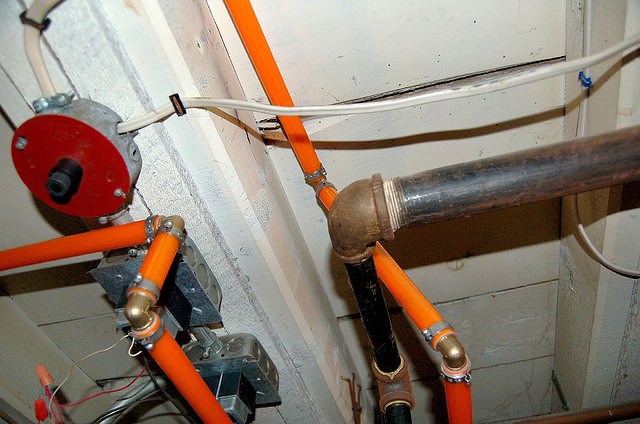PEX is a great material, but insurers must protect themselves and their clients.
Second to a building fire, water system failures are the most expensive perils in the construction insurer's risk portfolio. But there is little incentive for anyone to protect the insurer: After the engineering design for a plumbing system is done, the contractors are only liable for workmanship, and the manufacturer is only liable for materials. The insurer is liable for everything else.
The insurer must be aware of the pitfalls of a water system installation to both write the exclusions and investigate for liable cause in the event of a failure.
This article discusses a very popular plumbing material commonly referred to as PEX and addresses issues that may not be found in the actuarial tables.
PEX stands for “cross-linked polyethylene.” It is a relatively new material (less than 20 years) that has gained widespread acceptance in new construction piping and renovation re-piping for potable water systems. The reasons are obvious – PEX has flex; it is inexpensive; and the installation is fast, simple and reliable. Also, PEX will not burst in freezing conditions like CPVC or copper. PEX installations older than 30 years are common in Europe, with an excellent reliability record. PEX is especially desirable on re-pipes because it can greatly reduce the size of intrusions into walls, as plumbers can snake the material across smaller openings.
Unfortunately, there is some vulnerability that the insurer needs to be aware of. While we would always recommend obtaining a professional engineering opinion for assessing a PEX system, this short article will help the insurer understand what PEX is and how to evaluate the big vulnerabilities to using it: brass fittings, UV exposure, water quality and even vermin!.
Advantages
Cross-linked polyethylene is a modification of polyethylene plastic commonly found in children’s playground equipment. Cross-linking means that the individual "mers" in the "polymer" are bunched up into knots instead of aligned in one direction. This knotting allows the material to return to its original size and shape after being stretched. This is great for holding on to fittings, bending around corners and expanding under pressure, heat or even freezing conditions.
PEX is very fast to install and can be threaded through walls without having to necessarily cut out large sections of wallboard. Connections can be inspected visually with great reliability, and precise measurement is not as critical as it is with materials such as copper and CPVC. PEX has been widely used for several decades, with broad acceptance in the market and universal familiarity in the plumbing trade. Many different companies support PEX products with accessories and connectors such as manifolds, hangers and specialty adapters.
Concerns -- and Answers
PEX is clearly not without its own problems. Fortunately, many of them may be avoidable. In the engineering profession, we understand that it is rare for one single problem to cause a failure; rather, it is the combination of two or more problems that lead to the major accidents. Many times, accidents occur when one party does not communicate with another. With PEX, the owner, contractors, builders, maintenance personnel, etc. must be aware of the system configuration and have a plan for interacting with the system.
An insurer can have a strong impact in this area by specifying full disclosure of the hazards. For this reason, engineering counsel is often warranted in a complex system, to assist in assessing risks. Here are six areas that need to be addressed:
-- One risk is dezincification of the brass used in fittings. When the zinc content in the brass (an alloy of copper and zinc) is too high, it can corrode away. That leaves a weak and porous copper shell, which can lead to failure conditions ranging from persistent leaks to catastrophic breach of a pressurized line. At least one class action was filed against the makers of a particular brass fitting that was failing in service and causing substantial property damage. The root cause was found to be the dezincification of fittings (generally purchased in big box hardware stores and made cheaply overseas). This suit was settled for $90 million.
The problem of dezincification is now easily avoidable. The owner of a building should specify low-zinc brass fittings or use "engineered plastic" fitting components.
-- PEX was also suspected of leaching controversial chemicals such as MBTA, TBA and BPA that are considered toxic. While we cannot testify to the specifics of this claim, the state of California has banned PEX in many buildings. Given the segmented nature of permitting jurisdictions in the U.S., insurers should be aware of these concerns.
It is generally accepted that of the three types of PEX (called type A, B and C), type B is the only formulation that does not have any leaching considerations. Leaching concerns can be avoided by giving proper attention to leaching considerations as well as strength and temperature ratings among the three varieties. Insurers should be diligent about knowing what type of PEX is being used.
-- The stabilizers in PEX are highly vulnerable to breaking down under UV radiation -- while some sources may claim that some UV exposure is acceptable, we advise that all precautions should be taken to shield this material from UV rays. Even fluorescent lamps and CFLs are to be avoided, especially where piping is routed through a ceiling and may interact with recessed fluorescent lighting. There are many shielding products available to solve this problem. However, PEX is best-suited to total darkness. An insurer can easily specify protection from UV.
-- PEX is also known to be slightly vulnerable to chlorinated water and possibly copper ions, resulting from copper corrosion upstream. The temperature rating of the water must be strictly adhered to. Alone, these factors may not be worrisome in many applications. However, when combined with other aggravating factors, the aggressiveness of the water may amplify hazard potential. A test of water chemistry is advisable.
-- Most reputable builders will shield a PEX installation to keep a future owner or contractor from, say, hammering a nail into the wall and hitting the PEX. Homeowners should be aware of the potential to cause a leak by intruding through a wall with a nail or saw. Some contractors will use a thermal measurement device to identify water piping before cutting into a wall for any other reason. It is important for everyone who can interface with the system to know where PEX pipes are before cutting into a wall.
-- We have seen several instances where mysterious leaks appear in PEX installations when rodents are exterminated. The poison that is often used to kill small animals causes them to become very thirsty and seek water. Rats appear to be especially clever and can discern the sound of water flowing through PEX pipes – then rapidly chew through the PEX to access water. Make sure that all hired contractors -- from electricians to exterminators -- are licensed and experienced when interacting with a building that has a PEX system.
Conclusion
It can be seen that failures will most likely occur from the combination of two or more seemingly unrelated problems. It is rare that any single person or contractor is aware – on a scientific basis – of all these factors and the way that they can interact with each other. The owner of a building or maintenance personnel cannot be expected to know all of these details – they just install what they buy at the supply shop. It is important that the insurer is aware and able to assess or mitigate the vulnerabilities of PEX and watch the installation closely. A vigilant insurer will retain engineering counsel to oversee building specifications, construction, maintenance and forensics.


